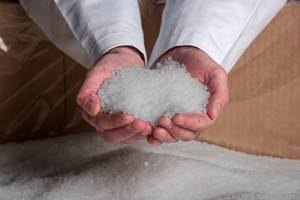Fundamentals Are Favorable For Packaging—If…
Wood On Plastics
Assuming policymakers are able to avoid an economic catastrophe, overall demand for plastics packaging will increase in 2013.
This is one of those times when I am reminded of just how large and important the word “if” can be. Under normal circumstances, this is the time of year when it would be my pleasure to write a column about the outlook for plastics packaging products in the coming year. Because under normal circumstances the outlook is generally favorable. But these are not normal circumstances.
As I write this, policymakers in Washington are grappling with the incredibly difficult issue of avoiding the “fiscal cliff.” Never in my memory has both the short-term and long-term outlook for the U.S. economy been so dependent on a single act of Congress.
If Congress does what needs to be done, then the U.S. economy will quickly gain momentum. The distractions of the recent election notwithstanding, the major macro-economic indicators are showing promise. The stock market has steadily increased during the past three years. Corporate profits are at or very near all-time highs. The employment data is rising.
Perhaps most importantly for processors of packaging products, the recovery in the residential housing and real estate sectors are finally accelerating. It’s not that housing and real estate sectors are large end-markets for packaging. But rather, these sectors are the best indicators of Americans’ propensity to consume all types of goods. The trends in retail sales at grocery stores and healthcare stores, as well as consumer spending for nondurable household goods—all good indicators of the demand for plastics packaging—are connected to the trends in housing.
The real problem is confidence levels, both among business leaders and consumers, and that is directly connected to the travails in Washington. We endured a long, grueling, and divisive election cycle. But now that the election is over, there is some real pent-up desire to get back to the business of becoming more productive. This desire will be unleashed as soon as a solution to the fiscal cliff is passed. If a solution is not reached in a timely manner, then the economy will enter a recession.
Let’s assume for the sake of my outlook that the elected policymakers are able to avoid a catastrophe. If that happens, then overall demand for plastics packaging products will increase in 2013. The expansion will start slowly because it will take some time to get the economy cranked up from its present state of limbo. But by the end of the second quarter the pace of economic acceleration should be noticeable to everyone. My current forecast calls for an overall gain of 4% in U.S. production of plastic packaging products in 2013.
There will be some issues with resin prices in the near term, but these problems should become less acute in the coming years. The U.S. petrochemical industry is rapidly converting to the use of more domestically-produced natural gas. This should result in lower prices for resins.
Another factor that may hold resin prices down is an increasing supply of recycled materials. The overall rate of recycling in the U.S. has not changed much in recent years, but there seems to be a slow rise in awareness of this issue. It is still too early to determine just how large an impact the sustainability programs of major retailers such as Wal-Mart will have on this nation’s recycling rates, but they could be a significant factor in the years to come.
WHAT THIS MEANS TO YOU
•Plastic bag and bottle bans by municipalities have risen, but the plastics industry’s response has improved greatly. This issue will not go away in 2013, but I expected it to lose steam gradually.
•Profit levels for companies that process food and kindred products are an important factor in the development of new packaging.
•Packaging design in the future will be driven less by aesthetic appeal and more by sustainability factors such as recyclability and content information.
About the Author
Bill Wood, an economist specializing in he plastics industry, heads up Mountaintop Economics & Research, Inc. in Greenfield, Mass. Contact BillWood@PlasticsEconomics.com.
Related Content
What to Look for in High-Speed Automation for Pipette Production
Automation is a must-have for molders of pipettes. Make sure your supplier provides assurances of throughput and output, manpower utilization, floor space consumption and payback period.
Read More‘Monomaterial’ Trend in Packaging and Beyond Will Only Thrive
In terms of sustainability measures, monomaterial structures are already making good headway and will evolve even further.
Read MoreFoam-Core Multilayer Blow Molding: How It’s Done
Learn here how to take advantage of new lightweighting and recycle utilization opportunities in consumer packaging, thanks to a collaboration of leaders in microcellular foaming and multilayer head design.
Read MoreUS Merchants Makes its Mark in Injection Molding
In less than a decade in injection molding, US Merchants has acquired hundreds of machines spread across facilities in California, Texas, Virginia and Arizona, with even more growth coming.
Read MoreRead Next
Making the Circular Economy a Reality
Driven by brand owner demands and new worldwide legislation, the entire supply chain is working toward the shift to circularity, with some evidence the circular economy has already begun.
Read MoreSee Recyclers Close the Loop on Trade Show Production Scrap at NPE2024
A collaboration between show organizer PLASTICS, recycler CPR and size reduction experts WEIMA and Conair recovered and recycled all production scrap at NPE2024.
Read MoreFor PLASTICS' CEO Seaholm, NPE to Shine Light on Sustainability Successes
With advocacy, communication and sustainability as three main pillars, Seaholm leads a trade association to NPE that ‘is more active today than we have ever been.’
Read More






















